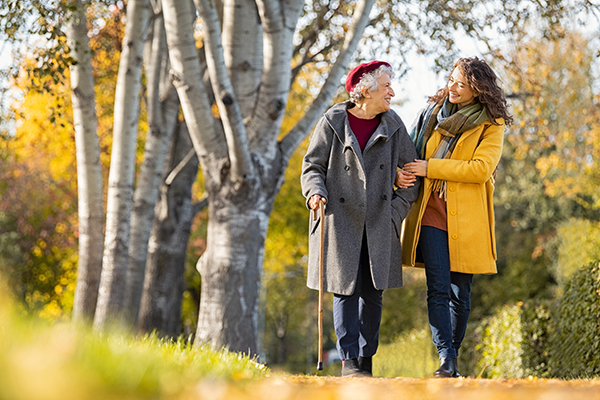Finding Your Balance
5 Ways to Prevent Falls for the Cancer Survivor
by Katie Schmitt, PT, DPT
Balance is something we all must work to improve. For survivors of cancer, improving balance is even more important, as the side effects of chemotherapy, radiation, surgery, and other treatments can increase your risk for falls. Here are 5 things you can do to improve your balance as a cancer survivor.
1 Rub your feet. Neuropathy is a common side effect of treatment with neurotoxic chemotherapy. Chemotherapy-induced peripheral neuropathy (CIPN) is common in both the hands and the feet of cancer survivors. It can start after the first treatment, or begin months after treatment is over. Neuropathy disrupts peripheral nerve signals and makes it harder for the muscles in your hands and feet to work correctly, resulting in numbness, tingling, burning, and feeling like you are walking on rocks. When you cannot feel your feet, or if they feel “off,” it can make walking difficult and put you at risk of falling. Rubbing your feet helps to stimulate the muscles, activate the nerves, and increase circulation in your feet. To reap the benefits, rub your feet (and your hands if you are experiencing neuropathy in the hands) for about five minutes per foot, twice a day.
2 Try balancing exercises. Many side effects of cancer treatment may leave you feeling off balance. Balance issues are prevalent in survivors with breast cancer, lung cancer, non-Hodgkin lymphoma, and prostate cancer. The main mechanisms that control your balance are your feet, your eyes, and your inner ear. You can improve your balance with balancing exercises that activate these mechanisms. To start, stand in a corner, somewhere safe where you can catch a wall if you get off balance. Place one foot in front of the other, like you are standing on a balance beam, and try not to touch the wall for support for 10 to 30 seconds. To progress this further, have a family member stand near you to protect you as you try to balance in this pose with your eyes open and then closed, and with your head turned to the right and then to the left. As you get better at balance, practice standing this way when waiting in line at the pharmacy, brushing your teeth, or taking a phone call.
For survivors of cancer, improving balance is even more important,
as the side effects of chemotherapy, radiation, surgery, and other treatments can increase your risk for falls.
3 Start a walking program. Having issues with balance and being concerned about your fall risk after cancer diagnosis may make you more sedentary at home. Additionally, chemotherapy can result in cardio and pulmonary toxicity, making you feel more tired more quickly. And neuropathy may make it painful to walk. However, keeping a routine of walking three times a week for 10 to 30 minutes can increase your circulation, improve your balance, and strengthen your body while helping to clear your mind. Start small by walking laps around your living room, and then work up to longer walks outside. If you live in a place without adequate sidewalks, take a walking stick, a rollator walker, or a friend with you.
4 Practice weekly strengthening. The American College of Sports Medicine recommends 150 minutes of moderate-intensity exercise per week to combat things like cancer-related fatigue, anxiety, depression, and pain. For breast and prostate cancer survivors, bone health will be an added concern because of the side effects of medication taken for these cancers. Aim to pair your thrice weekly walking program with two days of strengthening. The goal is to work your arms and legs for about eight to ten repetitions of each strengthening exercise. A good program may include bicep curls, shoulder flexion, rowing, marches, sit to stands, backward leg kicks, and writing the alphabet with your ankles using your big toe as the pointer. Remember, take rest breaks as needed and stop if you feel any pain. If you want to work with weights or resistance bands, talk to your oncologist to make sure these exercises are safe for you.
5 Assess your house. You may have had great balance before being treated for cancer and never have considered how many fall risks are in your home. Things like throw rugs, narrow walkways between furniture, and decorative items that stand on the floor may trip you up. Assess your home for fall safety. Make sure there is nothing that will catch your toe, like an ottoman or coffee table. See that the walkway to the bathroom is well lit. And while you’re in bed recovering, be sure you have everything you need nearby to reduce unnecessary trips through the house.

Dr. Katie Schmitt is a physical therapist at Hollings Cancer Center, part of the Medical University of South Carolina, in Charleston, SC. Her specialty is working with people who have CIPN and helping survivors of all ages and cancer types get stronger, beat the side effects of cancer treatment, and get back to being themselves and doing the things they love. For more information about Dr. Schmitt, and for videos demonstrating ankle exercises and neuropathy massage, visit drkatiedpt.com.
To learn more about fall prevention, check out the U.S. Centers for Disease Control and Prevention’s STEADI program at cdc.gov/steadi.
This article was published in Coping® with Cancer magazine, Winter 2023.


